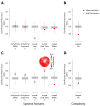Ongoing Dynamics of Peak Alpha Frequency Characterize Hypnotic Induction in Highly Hypnotic-Susceptible Individuals
- PMID: 39335379
- PMCID: PMC11430530
- DOI: 10.3390/brainsci14090883
Ongoing Dynamics of Peak Alpha Frequency Characterize Hypnotic Induction in Highly Hypnotic-Susceptible Individuals
Abstract
Hypnotic phenomena exhibit significant inter-individual variability, with some individuals consistently demonstrating efficient responses to hypnotic suggestions, while others show limited susceptibility. Recent neurophysiological studies have added to a growing body of research that shows variability in hypnotic susceptibility is linked to distinct neural characteristics. Building on this foundation, our previous work identified that individuals with high and low hypnotic susceptibility can be differentiated based on the arrhythmic activity observed in resting-state electrophysiology (rs-EEG) outside of hypnosis. However, because previous work has largely focused on mean spectral characteristics, our understanding of the variability over time of these features, and how they relate to hypnotic susceptibility, is still limited. Here we address this gap using a time-resolved assessment of rhythmic alpha peaks and arrhythmic components of the EEG spectrum both prior to and following hypnotic induction. Using multivariate pattern classification, we investigated whether these neural features differ between individuals with high and low susceptibility to hypnosis. Specifically, we used multivariate pattern classification to investigate whether these non-stationary neural features could distinguish between individuals with high and low susceptibility to hypnosis before and after a hypnotic induction. Our analytical approach focused on time-resolved spectral decomposition to capture the intricate dynamics of neural oscillations and their non-oscillatory counterpart, as well as Lempel-Ziv complexity. Our results show that variations in the alpha center frequency are indicative of hypnotic susceptibility, but this discrimination is only evident during hypnosis. Highly hypnotic-susceptible individuals exhibit higher variability in alpha peak center frequency. These findings underscore how dynamic changes in neural states related to alpha peak frequency represent a central neurophysiological feature of hypnosis and hypnotic susceptibility.
Keywords: alpha frequency; altered state of consciousness; aperiodic activity; arrhythmic activity; classification; hypnosis; machine learning; resting-state EEG; spectral analysis.
Conflict of interest statement
The authors declare no conflicts of interest.
Figures


References
-
- Jensen M.P., Jamieson G.A., Lutz A., Mazzoni G., McGeown W.J., Santarcangelo E.L., Demertzi A., De Pascalis V., Bányai É.I., Rominger C. New directions in hypnosis research: Strategies for advancing the cognitive and clinical neuroscience of hypnosis. Neurosci. Conscious. 2017;2017:nix004. doi: 10.1093/nc/nix004. - DOI - PMC - PubMed
-
- Laurence J.-R., Beaulieu-Prévost D., Du Chéné T. Measuring and understanding individual differences in hypnotizability. In: Barnier A.J., Nash M.R., editors. The Oxford Handbook of Hypnosis: Theory, Research, and Practice. Oxford University Press; New York, NY, USA: 2008.
-
- Bates B.L. Individual differences in response to hypnosis. In: Rhue J.W., Lynn S.J., Kirsch I., editors. Handbook of Clinical Hypnosis. American Psychological Association; Washington, DC, USA: 1993. pp. 23–54.
-
- McConkey K.M., Barnier A.J. High hypnotisability: Unity and diversity in behaviour and experience. In: Heap M., Brown R.J., Oakley D.A., editors. The Highly Hypnotizable Person: Theoretical, Experimental and Clinical Issues. Routledge; New York, NY, USA: 2004. pp. 61–84.
Grants and funding
- #280/16/Bial (Portugal)
- Bourse Post-Doctorale (BX3)/Fonds de Recherche du Québec - Nature et Technologies
- Post-Doctoral Fellowship/Natural Sciences and Engineering Research Council
- Programme Audace (Fonds #337355)/Fonds de recherche du Québec
- Fonds #2021-03426/Natural Sciences and Engineering Research Council
LinkOut - more resources
Full Text Sources
Miscellaneous

